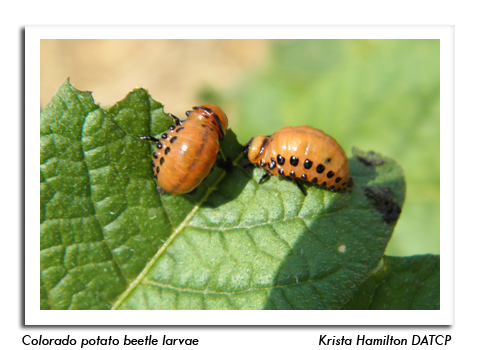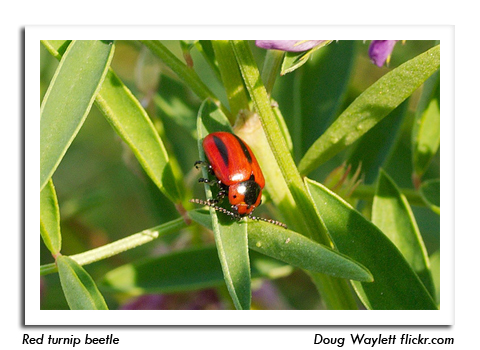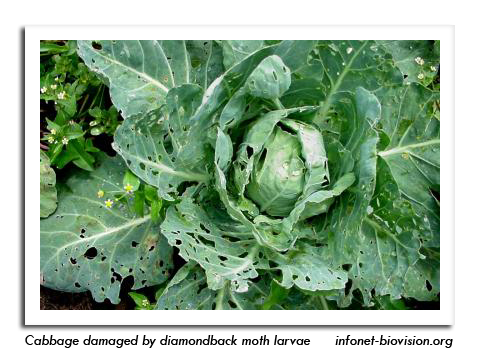
 |
|
|
Vegetables
Volume 64 Number 9 Date 06/27/2019 POTATO LEAFHOPPER - Populations have increased noticeably since mid-June, and nymphs are appearing in alfalfa and other crops. A threshold of one nymph per 10 leaves or one adult per sweep indicates control is justified for snap beans. The threshold for potatoes is 2.5 nymphs per 25 leaves or 0.5-1.0 adult per sweep. SQUASH VINE BORER - The summer emergence of moths is anticipated next week. Their presence signals that vegetable growers should begin checking vine crops for the flat, brown eggs deposited at the base of stems. Control is required immediately after the eggs are found to prevent the larvae from boring into the vines. Gardeners may remove the eggs by scraping them off with a fingernail. Covering plants with row covers or netting to prevent egg deposition and placing yellow pheromone-baited sticky traps around plantings may also help to reduce problems. A conventional insecticide or kaolin clay applied to the plant bases as a weekly spray during the three- or four-week egg laying period can provide protection if the sprays thoroughly cover the plant stems and are applied repeatedly to assure good control. COLORADO POTATO BEETLE - Larvae from overwintered beetles are predominantly in the early instars in southern and central Wisconsin. Controls should begin at this time, now that egg masses have hatched and while the majority of larvae are still small. Most first-generation CPB larvicide products must be reapplied 2-3 times at 7 to 10-day intervals to control populations. RED TURNIP BEETLE - This red and black beetle has been observed in Adams County alfalfa. Red turnip beetle is a sporadic pest in the Central Sands area of the state, feeding on plants in the mustard family. Hosts include broccoli, cabbage, kohlrabi, radish and turnip, but hoary alyssum and yellow rocket are thought to be the primary food plants. Small seedlings and transplants are the most susceptible to red turnip beetle feeding, while established plants can tolerate severe defoliation. Removing the adult beetles by hand is the recommended control. Beetle numbers usually decline by early to mid-July. CUTWORMS - A Milwaukee County CSA grower reports experiencing the worst cutworm infestation of her 20 years of growing. The caterpillars have invaded her hoophouses and are attacking seedlings under lights in her garage. Cutworms are active throughout the summer, but are rarely a problem after spring. Problems can be reduced by placing aluminum foil or cardboard collars around transplants to create a barrier that stops cutworm feeding. If damage or larvae are discovered, the cutworms should be physically removed and crushed or dropped into soapy water. CABBAGE CATERPILLARS - Low to moderate infestations of diamondback moths and imported cabbageworms were recently observed in southern and western Wisconsin community gardens. The larvae of these cabbage pests feed on leaves and cause large ragged holes, eventually infesting the developing heads of broccoli, cabbage and cauliflower. Treatment thresholds are reached when 10% of cabbage in the early heading to mature head stages are infested, or 10% of broccoli and cauliflower in the first flower or curd to maturity phase are damaged. Cole crop growers are reminded that imported cabbageworms, diamondback moths and cabbage loopers are considered to be a single caterpillar complex, and the same infestation threshold applies to all three species. Bacillus thuringiensis (Bt) and chemical insecticides are effective controls for small caterpillars. STRIPED CUCUMBER BEETLE - Continued inspection of plants for these yellow and black striped beetles is advised. Populations are high in some western Wisconsin gardens, with vegetable growers reporting serious damage to cucurbits. Beetle control may be justified in home gardens and larger commercial muskmelon or cucumber operations for populations of 4-5 beetles per 50 plants. Bacterial wilt infection can develop when only 10% of the population are carriers of the pathogen. -- Krista Hamilton, DATCP Entomologist 





|
|
|